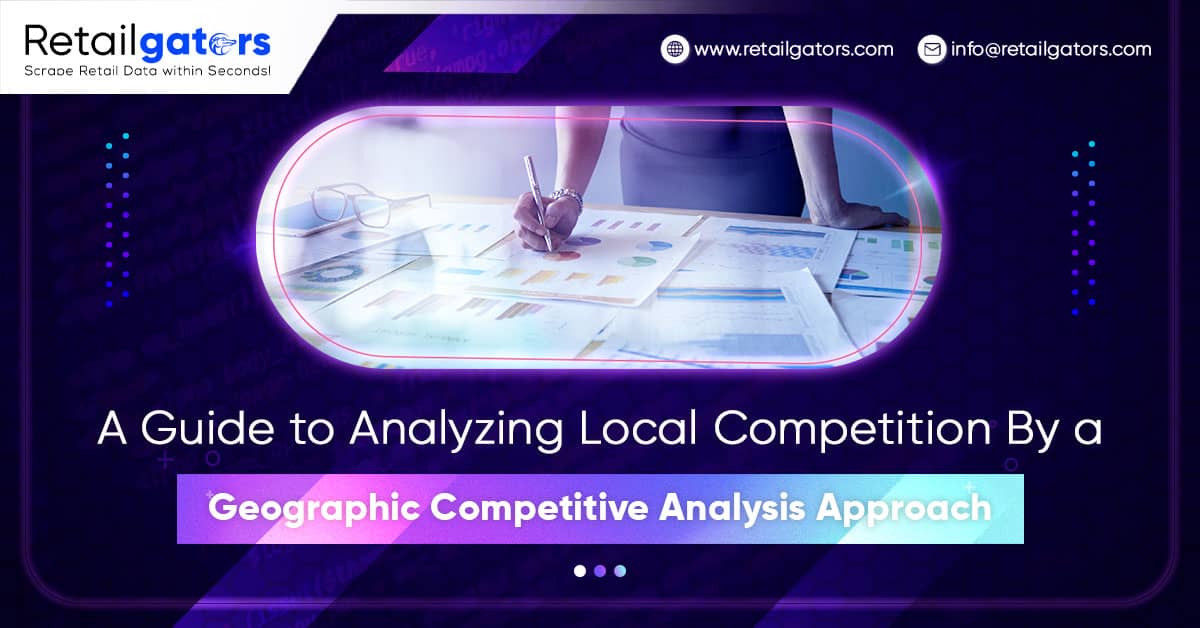
Competitive Monitoring and a Geographic Approach- A Glimpse

From helping spot opportunities to making the right business strategy, competitive price monitoring answers all the quests.
But exactly do we mean by the term rival's cost monitoring? What is a geographic approach, and how does the analysis work?
Well, let us dive deeper to know more:-
A competitive analysis, or a competitor analysis, is a method to evaluate how well the business and its products or services are performing compared to other companies selling similar products or services in the marketplace. Assessing the business at regular intervals can help find new opportunities overlooked before and areas of improvement amongst others.
A geographic approach helps in operating more efficiently, looking at risks more clearly, developing sustainably, and serving stakeholders correctly.
With price tracking becoming easier, businesses can know about the cost change instantly and in real-time. One can also make correct decisions related to their pricing strategy immediately. It aids in optimizing the cost strategy. The changes get monitored daily to have insights about other's products, including the prices and features of the tracked item.
For conducting cost monitoring, various tools can get used. Before selecting any tool for price monitoring, some basic features must accompany it. The software must possess an automated cost monitoring property and a rival stock movement tracker functionality. It must have an instant and quick reporting mechanism for price fluctuations. The tool must have the ability to perform repricing when required.
Benefits of Competitive Analysis

The benefits of Competitive cost monitoring are multiple. Let's get on and know more about it:-
1. Aids in Product Development
Competition is about developing out-of-the-league products to capture and revolutionize one's niche industry. By using the competitive analysis option, businesses can know about their rivals, the products being developed or worked upon, and other intricacies. With an understanding of where the competition stands, one can improve the products and services to gain an edge over the competitors.
2. Understanding Market Gaps
Competitive monitoring helps businesses understand areas of the market requiring efforts or improvement. Maybe the rival company is not catering to a particular market niche or rendering an inferior product. It may also happen that they do not allow product customization. The only method to find this relevant data is through competitive analysis.
Through this, businesses can also know about their competitor's geographical reach and underserved areas that may have opportunities for new players entering the market.
3. Helps in Staying Competitive
A factor that drives consumers' decisions is the price of the product. Today, users explore numerous deals by searching different websites. Here, the costs get optimized by the marketplace per customer demand and other relevant factors.
In such situations, price tracking helps the enterprise stay competitive by tracking prices. It helps generates better revenues by maximizing sales and profits.
4. Supports Revenue Increase
The information extracted from the websites gives industry insights that can offer a competitive edge. With the data extracted, the companies can make informed decisions and frame creative strategies and tactics to compete with others. Competitive analysis even helps know changes in customer preferences, thereby helping in stocking more demanded goods. With correct decisions, businesses can outplay their competitors and increase revenue in the long run.
5. Help Track Price Fluctuations
Deals, coupons, discounts, and special offers attract consumers. Big brands and companies, thus, keep changing their prices frequently. Although it is possible to know about the cost fluctuations, scanning numerous websites to know the same is overwhelming and tiresome. It can also lead to human errors.
Here, web scraping combined with price monitoring software makes data extraction easier, informing about real-time price variations.
Ways to Carry Out Competitive Analysis

Carrying out a price tracking analysis might seem like a pie in the sky, but in reality, they are not. Follow these simple steps to get started with Competitive Analysis:-
1. Identify the Overall Competitors
Begin by creating a list of every company operating in a similar industry. Start with basic keyword research. The next step is to categorize the companies into direct and indirect competitors.
- Direct rivals provide alike products or services to a target market similar to yours.
- Indirect competitors offer different products or services to a similar target market.
Owing to their names, direct competitors pose a direct risk to the business, whereas indirect competitors can attract consumers and pull businesses away.
2. Collecting Competitor Information
Sometimes the competitor's target market is evident, but in several cases, it might not come as easy. In such cases, collecting data about rival companies becomes evident. To do this, gather information about their mission statements as they explicitly indicate their products and services. The tonality of the competitors further tells about their offerings, including their social media engagement.
3. Understand the 4Ps
After gathering data about competitors, evaluate them using the 4Ps. The 4Ps in the market arena stand for Product, Price, Place, and Promotion.
Product
Learn about their products and compare them with your own, their features, and the qualities that make them likable amongst consumers. Think about ways to improve your services or products to reach out to the target customers efficiently.
Price
Know how they have priced their products and services, discount policy, and cost structures that have made their products more appealing among the target market.
Place
Find out about the service area and the geographic reach of the rival companies.
Promotion
Extract information about their marketing tactics and their presence on various social media platforms.
4. Familiarize Yourself with their SEO Strategy
SEO is the backbone of today's businesses. As such, by taking note of the competitor's keywords, one can understand what pages are getting more traffic, what is working for them, and what areas one has overlooked till now.
5. Understand their Popular Content
Figure out which types of content are popular with your competitors' customers to help with the content framing. The goal is to understand which content types get the most engagement and gets more attention from the audience. Learn about all the competitors to understand their social media strategy closely.
6. Perform a SWOT Analysis
SWOT stands for Strengths, Weaknesses, Opportunities, and Threats. This term means that one needs to look at the strengths and weaknesses present in the company. For opportunities and threats, look for external factors. All this will help form an efficient strategy to compete and stay ahead of others in the market.
Final Thoughts
With the boost in online shopping, brands should track competitors' prices to stay ahead of their competitors. Presently, web scraping combined with competitive tracking can help businesses in making beneficial strategies in the long run. From preventing wasted resources, offering new opportunities, and helping stay abreast of the competition, the analysis does wonders for enterprises. Indeed data scraping has revolutionized how brands work today, thus serving as a boon for both small and large enterprises alike.








Leave a Reply
Your email address will not be published. Required fields are marked